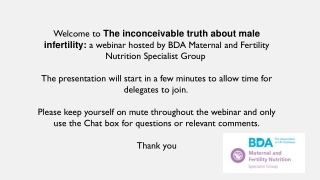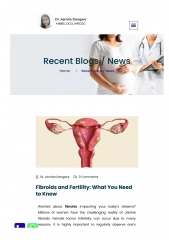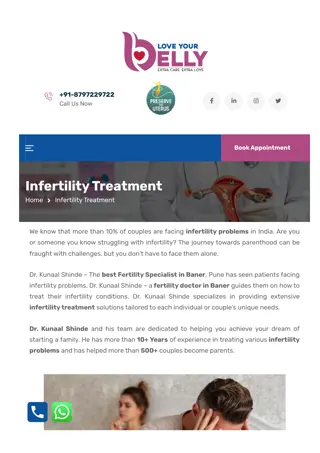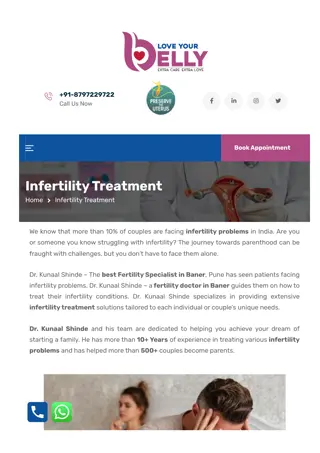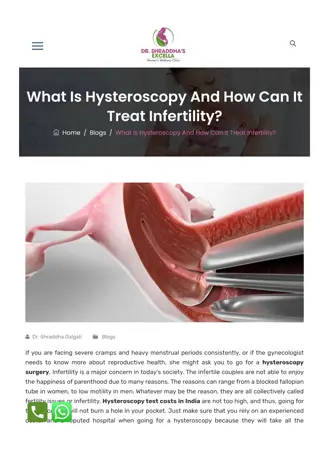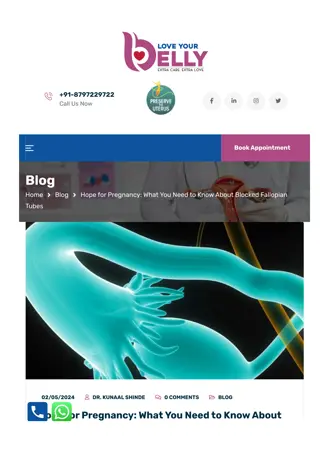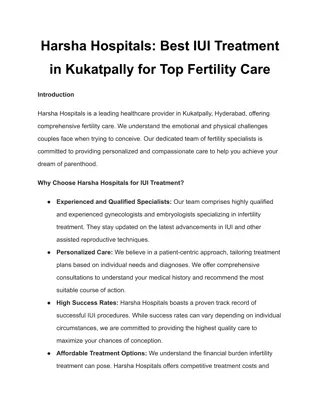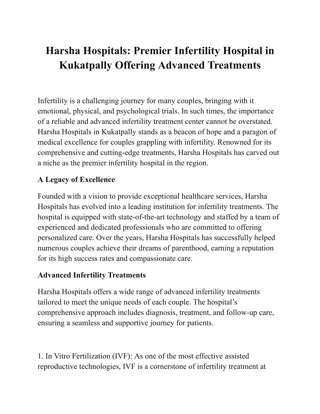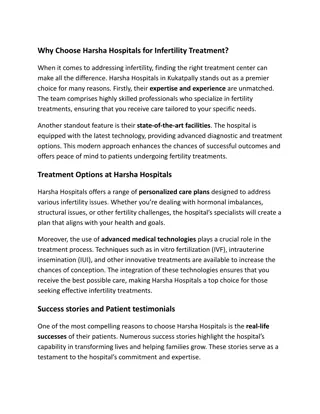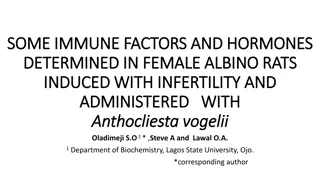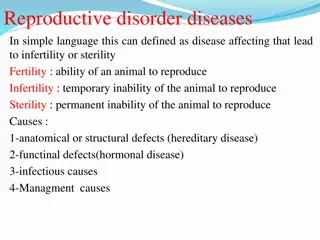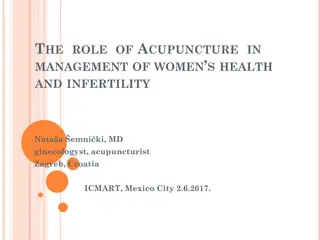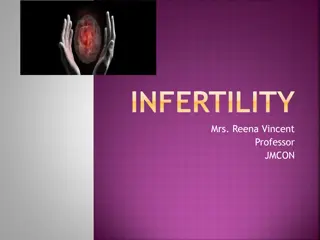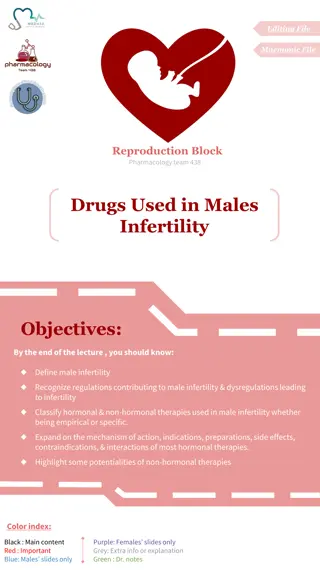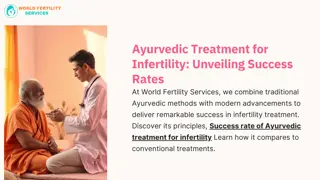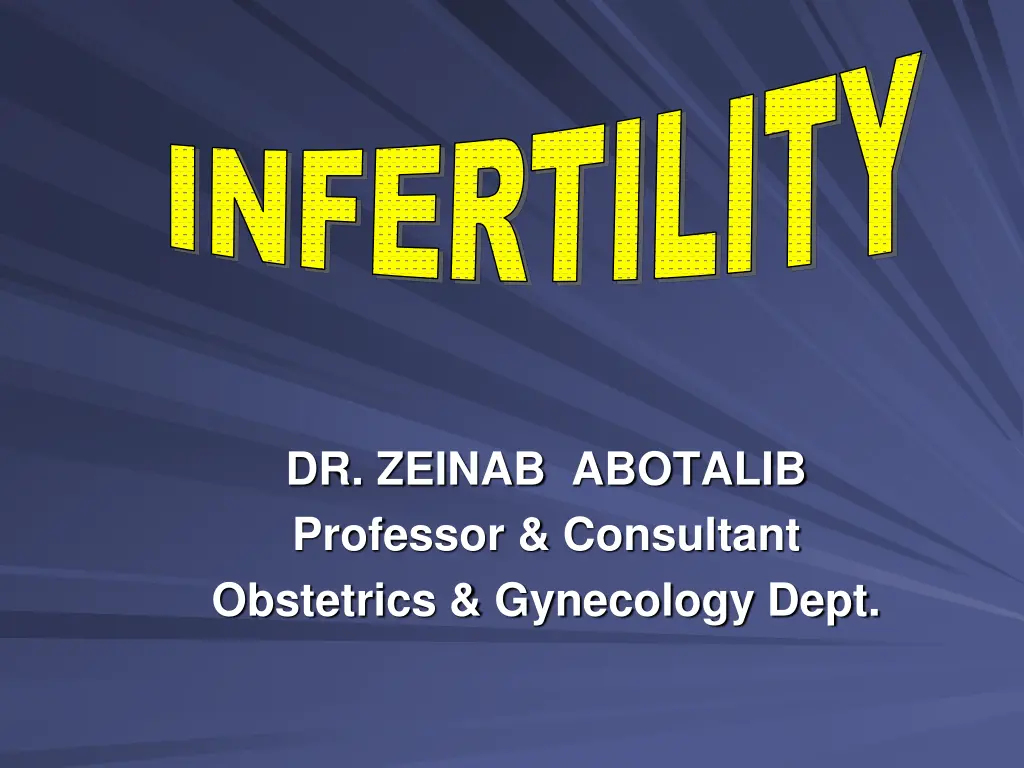
Understanding Infertility: Causes, Diagnosis, and Treatment Options
Explore the different causes of infertility, ranging from female factors like PCO and endometriosis to male factors like oligospermia. Learn about the diagnostic methods such as basal body temperature charting and semen analysis, and discover treatment options like ovulation induction and IVF. Gain insights into managing infertility with expert advice from Dr. Zeinab Abotalib, a renowned Obstetrics and Gynecology Consultant.
Download Presentation

Please find below an Image/Link to download the presentation.
The content on the website is provided AS IS for your information and personal use only. It may not be sold, licensed, or shared on other websites without obtaining consent from the author. If you encounter any issues during the download, it is possible that the publisher has removed the file from their server.
You are allowed to download the files provided on this website for personal or commercial use, subject to the condition that they are used lawfully. All files are the property of their respective owners.
The content on the website is provided AS IS for your information and personal use only. It may not be sold, licensed, or shared on other websites without obtaining consent from the author.
E N D
Presentation Transcript
INFERTILITY INFERTILITY DR. ZEINAB ABOTALIB Professor & Consultant Obstetrics & Gynecology Dept.
DEFINITION: A couple is considered infertile after unsuccessfully attempting to achieve pregnancy for one year. TYPES: Primary Secondary 80% of couple will conceive within the first year: 25% within 1st month 60% within 6 months 75% by 9 months 90% by 18 months After 18 months of unprotected sexual intercourse, the couple have low monthly conception rate without treatment.
CAUSES: 1. Female: Ovulatory PCO, hyperprolactinemia, thyroid dysfunction, obesity, age, stress. Tubal Adhesions, ectopic, PID Endometriosis ? Fibroid Cervical 2. Male Oligospermia Azozpermia Asthermospermia Poor morphology 3. Unexplained 30% of couples will fall into this category 4. Multiple causes will be in 40% of cases.
MANAGEMENT: 1. History Female -most women with regular cycles (every 22 to 35 days) are ovulating especially if they have premenstrual molimina. Male - especially smoking, type of work, mumps, sexually transmitted disease. 2. Examination Female Male - Height, size of the testes, secondary sexual charactetistics. 3. Investigation: Basal body temperature chart, spinnbarkeit test. FSH, LH, Prolactin level, thyroid function (follicular phase of the cycle) Progesterone, D21 of the cycle Laparoscopy + dye test Hysteroscopy 4. Semen Analysis
TREATMENT: According to the cause: 1. Ovulation induction Oral -Clomiphen citrate which is anti oestrogen Injections Gonadotropines, e.g. Menogon, which contains FSH Monitoring by ultrasound Risks of treatment multiple pregnancy hyperstimulation syndrome 2. Hyperprolactinemia Bromocriptin (Dopamin receptor agonist) 3. Tubal Laparoscopic adhesolysis Salpingoplasty 4. Intrauterine insemination (IUI) 5. IVF or ICSI Indications Bilateral tubal blockage Unexplaine infertility Serial treatment cycles with IUI and no pregnancy Male factor FSH and LH
PCO: Polycystic ovary Usually in obese woman Revised FSH: LH ratio, in the proliferative phase of the cycle Oestrogen Hirsutism Raised level of circulating insulin Raised blood sugar
DIAGNOSIS: 1. History - irregular cycle - - - recurrent abortions - oligonorrhoea Infertility ? galactorrhoea 2. Examination: - Investigation: LH FSH may be normal Oestrogen Free testosterone may be or normal Ultrasound - multiple small cysts at the periplery of the ovary looks like necklace. Laparoscopy thick, enlarged non-active ovaries Usually obese but it can happen in thin patients Hirsutism - 3.
TREATMENT: Weight reduction Induction of ovulation Metformin Laparoscopic ovarian diathermy IVF
HYPERPROLACTINE Could it be due to: Stress one reading is not enough to hyperprolactinemia. Secondary to TRH as in cases of hypothyroidism. Drugs antihypertensive antidependents dyes. Macro or micropituitary adenoma. Can lead to infertility by preventing ovulation or by causing luteal defects. or
DIAGNOSIS: History e.g. drugs Examination - Investigation - Treatment galatorrhoea visual equity prolactin level lateral skull X-ray CT Scan Bromocriptin ? Surgery - - - -
HIRSUITISM: Pathological - PCO, adrenal cortex trauma, Cushion syndrome Constitutional SITE: Face Chest Anterior abdominal wall INVESTIGATION: Free testosterone level, ATCH, FSH, LH
TREATMENT: Difficult needs reassurance Hair removal by different methods Diane Cypretone acetate anti-androgen Treatment will take long time

